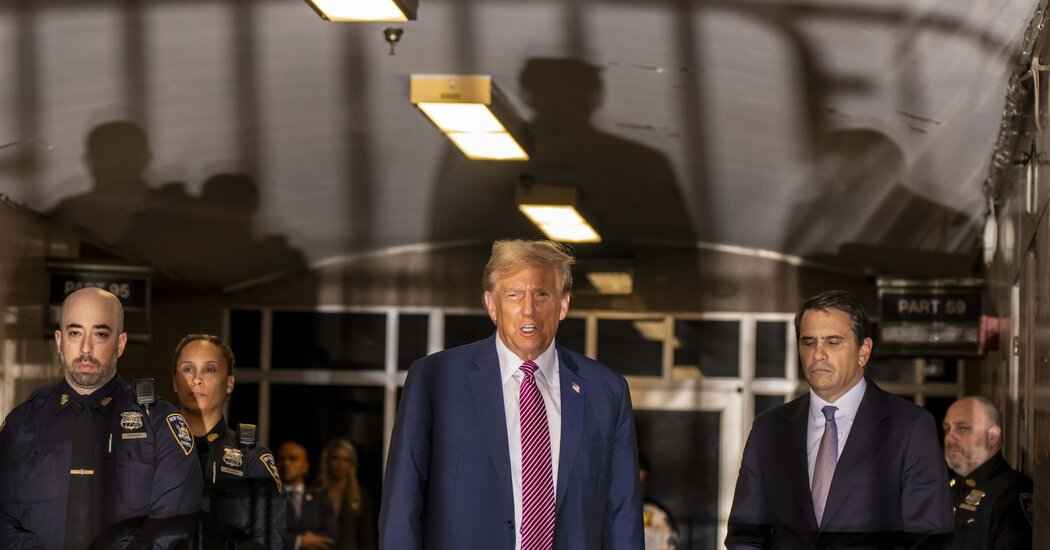For the next several weeks, the presumptive Republican nominee for president will be spending his days in a New York City courthouse. By any normal campaign standard, taking your candidate off the road for much of April and May of a presidential year would be devastating. But “normal” and Donald Trump live in different countries. The trial will afford Mr. Trump the opportunity to define the essence of his candidacy: I am a victim.
The very competent operatives running the Trump campaign didn’t draw this up as their ideal campaign plan, but they will appreciate its potential. The Manhattan courtroom will be the setting for Mr. Trump to play the role of a familiar American archetype: the wronged man seeking justice from corrupt, powerful forces. The former president is good in this role, and that’s no small thing.
Presidential campaigns pay a great deal of attention to scheduling — where, when and how many events should a candidate do on any given day. But here’s the most important element of scheduling: putting a candidate in a setting that gives them a chance to excel. In George W. Bush’s 2000 presidential campaign, our default event was to put him at a school, preferably one not in a wealthy ZIP code. Education was his signature issue as governor of Texas. He knew a lot about it, cared about it passionately, and the odds were it would be a successful event. It was not surprising to me that when planes struck the twin towers, President Bush was in an elementary school reading to students.
Mr. Trump loves big rallies. He feeds off the crowd like a vampire at a blood bank. But his act is getting a little old. Cable news no longer cuts live to these invariably repetitive events, and they don’t seem to drive as much conversation among voters as they once did. By contrast, the trial gives Mr. Trump the benefits of renewed interest from voters and the media with no burden on his team to increase campaigning or produce a newsworthy event.
I feel like I have spent half my life in campaign headquarters, staring at a map and a calendar. The map is always too large, and the calendar too short. Time is the one resource allocated to campaigns in exactly the same amounts. But there’s a dirty little secret to presidential campaigns: Where you campaign may be of little consequence. A courthouse could be as valuable as the swingiest swing district in the swingiest swing state.
When Joe Biden received more votes than any presidential candidate in history while largely campaigning from his basement, the MAGA world saw it as proof the campaign was stolen. But I wasn’t surprised. Struck by how much time and energy was spent in racing to campaign events, I asked a basic question in the 2012 Mitt Romney campaign: Does it matter where he goes? We started polling in markets a few days before and after an event, and the results were consistent. There was a three-to-four-point bump immediately after a big rally but it quickly evaporated. A week after the event, the market had reset to where it was before.
It was depressing but not particularly useful information. Any slowing of a campaign’s pace would have been perceived as weakness or surrender. Covid gave Mr. Biden a chance to opt out without penalty and put the focus instead where he wanted it (on the Trump White House’s disastrous handling of the pandemic). In its own way, the New York trial is offering an opt-out to Mr. Trump as well as a strategic opportunity.
The Trump campaign is not about persuasion. It’s about stirring up anger inside every possible Trump supporter so that voting is a righteous act of fury, not a mere civic duty. If you believe the deep state stole the last election, the legal persecution of Mr. Trump is further proof of the state’s desperation to keep him from reassuming his rightful place in the Oval Office. Combine all of that with a less-than-inspiring Biden coalition, and it’s a blueprint for a Trump Electoral College victory.
Relying on turning out an existing base of supporters (rather than broadening that base) is not new to the Trump campaign. And I get it: In 2004, we found it difficult to persuade new voters in the Bush campaign. I remember sitting in focus groups and showing ads about women voting in Afghanistan that would bring the room to tears. Followed by them saying, “But you know I’m not voting for the guy.” Out of that reality came the plan known as “fortress precincts.” The focus became increasing the turnout percentage of Bush supporters and how to get a precinct that went 60 percent for Mr. Bush in 2000 to increase to 64 percent.
It worked, if barely. Had less than the home game crowd at an Ohio State football game changed their votes, Ohio would have made John Kerry the 44th president. What’s different about Mr. Trump’s approach is that polarization is the key to his turnout strategy, which creates energy for Mr. Trump by enraging non-Trump voters. Everything about the Trump campaign is about driving Americans apart. Mr. Trump opens his rallies with a rendition of the national anthem by a group of men imprisoned for their parts in the Jan. 6 insurrection, on which he also recites the Pledge of Allegiance. “I am your retribution” is a long way from “I am a uniter, not a divider” and “Hope and Change.”
In this strategic paradigm, indictments and subsequent court appearances are a gift from the political gods. Mr. Trump is a candidate of anger and grievance, which has always had a strange quality for someone who was a millionaire in high school. How can the man with a golden toilet be a victim? White grievance was Mr. Trump’s on ramp to the victim podium in his previous runs. That’s still essential to the Trump candidacy, but now, in his telling, he can add the burden of persecution by corrupt (and mostly nonwhite) prosecutors to the cross he carries to that Calvary hill called the White House.
Six weeks or more is a long run for a 77-year-old performer in a one-man show with no understudy. The judge has correctly made it clear he will not allow the looming election to affect the proceedings. The energy of the opening days will fade in the long grind of a trial. To me, this trial is really about whether Mr. Trump actually paid $130,000 to a porn star without any sex to show for it. That absurdity may begin to sink in with the few voters still in play. But we should not normalize how extraordinary it is that Mr. Trump is still a viable candidate for president. The Biden campaign will watch the spectacle unfold, asking, “How is this guy still in the race?”
It’s a good question. But he is. And he can win.
Stuart Stevens is a former Republican political consultant who has worked on many campaigns for federal and state office, including the presidential campaigns of George W. Bush and Mitt Romney.
The Times is committed to publishing a diversity of letters to the editor. We’d like to hear what you think about this or any of our articles. Here are some tips. And here’s our email: letters@nytimes.com.
Follow the New York Times Opinion section on Facebook, Instagram, TikTok, WhatsApp, X and Threads.








